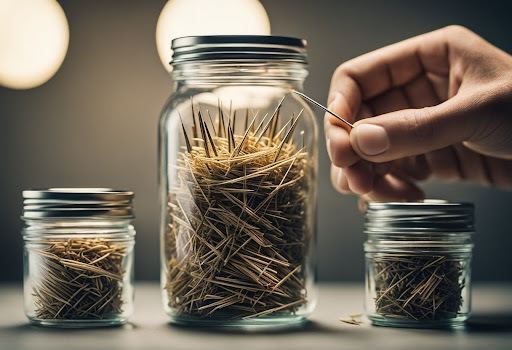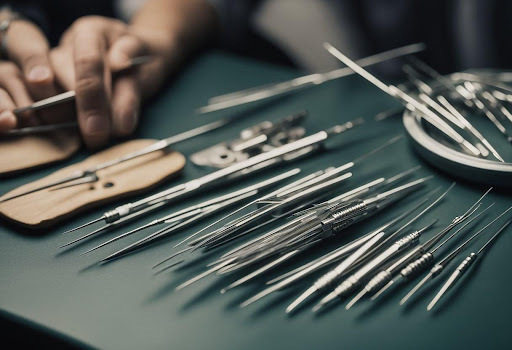Find the Perfect Needle for Your Project: A Comprehensive Guide
Selecting the right needle for your sewing project can be as crucial as choosing the right fabric or thread. Each project demands a specific type of needle for optimal results, and understanding the differences can make all the difference. The dimensions and characteristics of a needle affect how it interacts with the fabric, influencing both the sewing process and the final appearance of your work.

Needles vary in size, and using the correct size is essential to accommodate different fabric weights and thicknesses. A needle too small may break easily, while one too large can damage the fabric. Additionally, the eye and tip of the needle are important features to consider. The eye must be large enough to thread easily but not so large that it creates unnecessary friction. The tip needs to be appropriate for the fabric—a sharp point for wovens and a rounded tip for knits.
For special materials and techniques, specialty needles are available. These needles are designed for specific tasks, such as embroidery or quilting, where standard needles may not suffice. They enhance the user's ability to tackle unique projects with precision and ease. Understanding the nuances of specialty needles can expand your sewing capabilities and allow you to approach a wider range of projects with confidence.
Key Takeaways
- The right needle choice is integral to the success of a sewing project.
- Needle size, eye, and tip shape affect the sewing interaction with fabric.
- Specialty needles cater to unique materials and sewing techniques.
Needle Size

In knitting and sewing, needle size is crucial for achieving the desired outcome in our projects. We use finer needles for delicate fabrics and lightweight yarns, while thicker needles are better suited for heavy materials and chunky yarns.
Knitting Needles:
|
Metric Size (mm) |
UK Size |
US Size |
Yarn Weight |
|
2.0 - 3.25 |
14 - 10 |
0-3 |
Lace - Light |
|
3.5 - 4.5 |
9 - 7 |
4-7 |
DK - Worsted |
|
5.0 - 8.0 |
6 - 0 |
8-11 |
Chunky |
|
8+ |
00+ |
13+ |
Super Chunky |
Remember that the thicker the needle, the larger the stitch it produces, and vice versa.
Sewing Needles:
We opt for different sizes of sewing needles depending on the fabric's weight and texture. For sewing, needle sizes are typically indicated by numbers—the higher the number, the larger the needle.
- Hand Sewing Needles: Range from size 1 to size 10; size 1 is the largest, best for heavy fabrics.
- Machine Sewing Needles: Typically between 60/8 and 120/19; the first number reflects the European sizing and the second the American.
When selecting sewing needles, whether for handwork or machine, we also consider the fabric type and thread size to ensure our needle choice complements these factors appropriately, resulting in finished projects of superior quality.
By adhering to these guidelines, we can ensure our projects are well-crafted and our tools are perfectly matched to our materials.
Eye and Tip of the Needle
When selecting the ideal needle for our project, we must consider both the eye and the tip of the needle as these parts play vital roles in its functionality. The eye of the needle is where we thread our material. Its size and shape can greatly affect the ease with which we can thread it and the type of thread it can accommodate. Here are common types of needle eyes:
- Standard Eye: Suitable for most sewing tasks.
- Long Eye: Often found in needles designed for embroidery or beading, allowing for easy threading of multiple threads or thicker yarns.
- French Eye: Also known as a 'self-threading eye', useful for those who find threading a needle challenging.
Moving to the tip of the needle, it's designed to penetrate fabric with minimal resistance. Different types of tips include:
- Sharp Point: Ideal for most woven fabrics.
- Ball Point: Best for knit fabrics as it avoids breaking the fibres.
- Leather Point: A wedged tip that pierces through leather without tearing it.
|
Type of Needle Tip |
Best Use Case |
|
Sharp Point |
Woven fabrics |
|
Ball Point |
Knits and stretch materials |
|
Leather Point |
Leather and heavy non-wovens |
We must match the needle type to our fabric and thread to ensure the best results. Choosing the correct eye and tip combination will help us achieve a smooth sewing experience and a high-quality finish to our projects.
Specialty Needles
_2.jpg)
When embarking on a new project, it's crucial that we select the right type of needle to ensure the best possible outcome. Specialty needles are designed for specific tasks, and using them can greatly enhance our work.
Types of Specialty Needles:
- Quilting Needles: These needles have a tapered point allowing us to sew through multiple layers and across seams.
- Embroidery Needles: With a larger eye, they accommodate embroidery threads and prevent fraying.
- Leather Needles: These needles have a chisel point, designed to pierce through tough materials without tearing.
Specialty Needle Features:
- Material: Often made from stronger materials to withstand specific textiles.
- Coating: Some have special coatings, like titanium, to reduce wear and friction.
- Eye Design: Larger eyes for easy threading of specialty threads.
For delicate fabrics and heirloom stitching, we turn to:
|
Needle Type |
Use Case |
Characteristics |
|
Milliner's Needles |
Pleating and decorative stitching |
Long and fine with a small, round eye |
|
Tatting Needles |
Lace making |
Long with a large eye, similar to a sewing needle |
|
Beading Needles |
Adding beads and embellishments |
Very thin with a long eye to hold thin beading thread |
By choosing the appropriate specialty needle, we can approach our project with confidence, ensuring precision and care in our execution.



